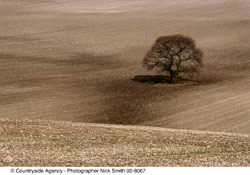Modern
 Following the Napoleonic Wars conditions in the countryside for the poor were dire, and town populations grew rapidly. By the end of the 19th century more people were working in industries based in towns than were working in agriculture. There were economic crises in the 1820s and 1870s, and the 'Captain Swing' riots took place across Wiltshire in 1830. Even at the beginning of the 20th century most farm labourers still lived in thatched or tiled cottages with open fires and no running water. Shepherds often lived on their own on the downs, in wheeled huts, sometimes remaining there even in winter.
Following the Napoleonic Wars conditions in the countryside for the poor were dire, and town populations grew rapidly. By the end of the 19th century more people were working in industries based in towns than were working in agriculture. There were economic crises in the 1820s and 1870s, and the 'Captain Swing' riots took place across Wiltshire in 1830. Even at the beginning of the 20th century most farm labourers still lived in thatched or tiled cottages with open fires and no running water. Shepherds often lived on their own on the downs, in wheeled huts, sometimes remaining there even in winter.
The First World War saw further woodland and scrub clearance, and large areas of open downland ploughed up for cereals. Following the end of the war there was increased mechanisation on farms, and farm labouring as a way of life declined rapidly. There were further falls in rural population, partly because so many labourers and gamekeepers had been killed during the war. The shortage of labour meant that steam ploughs were increasingly used to plough fields. Market plots for vegetables and the '3 acres and a cow' scheme were launched by the government of Lloyd George to encourage smallholders. In the 1920s however prices for wheat, cattle and milk fell, and there was further economic and social hardship as part of the Great Depression. In the 1930s transportable milking parlours were introduced onto some farms, and there were government drives to increase arable production with the threat of war. During the Second World War many areas of downland that had been under pasture for centuries were ploughed up again to maximise arable production.
Post-war intensification of agriculture continued with the ploughing of slopes and elevated downland, and the removal of hedgerows and field boundaries to create large scale fields. This resulted in loss of archaeological features and, in some instances, loss of topsoil, a decline in chalk grasslands and hedgerows, with an associated decline in wild plant, bird and insect species. Some areas are now once again improving - hedgerows are being re-planted and agri-environment schemes have started to encourage animal and plant species back to the downlands.
This document forms part of the wider AONB Historic Environment Action Plans.
